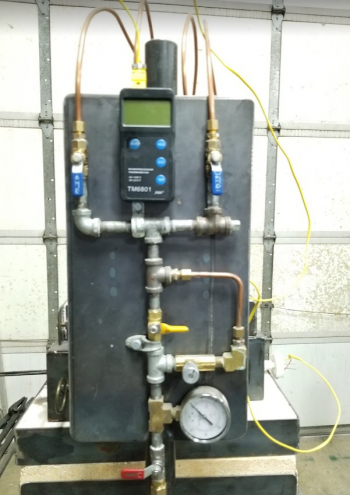MTBob
Well-Known Member
It seems everything I read says that I need an electric oven to heat treat stainless steel. Apparently the electric oven provides better temperature control.
But, that's where the numbers don't add up for me. Let's say I'm shooting for a 1500F austenitizing temperature. Ovens like Paragon and Evenheat apparently have temperature tolerances that are around +/- 2-3%, and perhaps may go up to 5-7%. So, using a temperature variation of , say, +/-3% that means the electric ovens may vary as much as 45F, or 1455-1545F.
I built a 2 burner heat treating forge that gives me the ability to control temperatures in the +/- 25F range at austenitizing temperatures. I use a digital readout with a type K probe, with the probe mounted inside a tubular steel baffle next to the blade(s) being heated. The digital readout claims to have a tolerance of +/- .2-3%, a very small temperature tolerance.
So, my question is this - Is temperature control the only reason I need an electric oven to HT stainless? If that's the case, I think I can equal or beat the standard electric oven heat treating temperature tolerances. But, to be clear, controlling target HT temperatures on my forge does require some "nimble" maneuvering with the gas valves. Note the gas bypass valve (yellow handle) that lets me more accurately control the gas flow through a small needle valve.
Do Evenheat & Paragon ovens actually have notable temperature swings while trying to hold a target temperature? If so, what's your experience with your oven?
Here's the gas control panel & flame baffle.


But, that's where the numbers don't add up for me. Let's say I'm shooting for a 1500F austenitizing temperature. Ovens like Paragon and Evenheat apparently have temperature tolerances that are around +/- 2-3%, and perhaps may go up to 5-7%. So, using a temperature variation of , say, +/-3% that means the electric ovens may vary as much as 45F, or 1455-1545F.
I built a 2 burner heat treating forge that gives me the ability to control temperatures in the +/- 25F range at austenitizing temperatures. I use a digital readout with a type K probe, with the probe mounted inside a tubular steel baffle next to the blade(s) being heated. The digital readout claims to have a tolerance of +/- .2-3%, a very small temperature tolerance.
So, my question is this - Is temperature control the only reason I need an electric oven to HT stainless? If that's the case, I think I can equal or beat the standard electric oven heat treating temperature tolerances. But, to be clear, controlling target HT temperatures on my forge does require some "nimble" maneuvering with the gas valves. Note the gas bypass valve (yellow handle) that lets me more accurately control the gas flow through a small needle valve.
Do Evenheat & Paragon ovens actually have notable temperature swings while trying to hold a target temperature? If so, what's your experience with your oven?
Here's the gas control panel & flame baffle.


